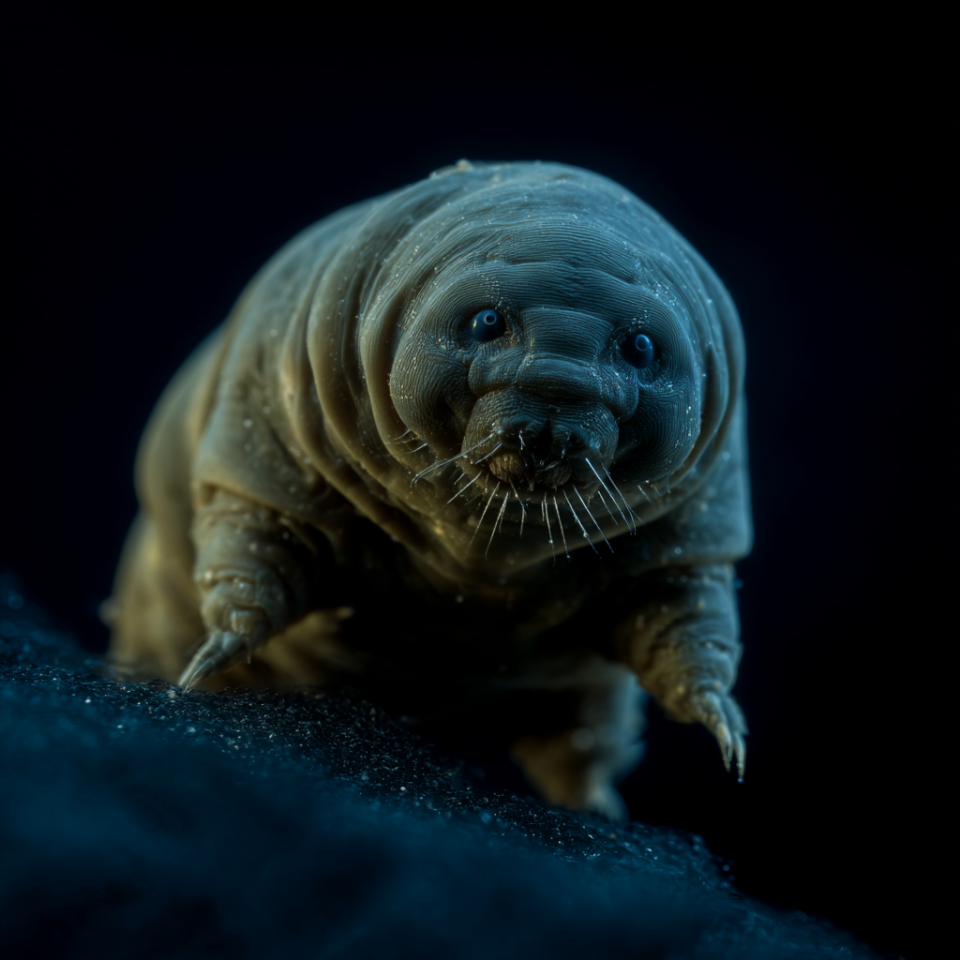Muinakari (MOO-ee-nah-kah-ree)
Eutardigrades
In the soft underlayers of leaf mold and water droplets suspended between moss strands, the Muinakari moves—slow, deliberate, and nearly imperceptible. Though unseen to most, their presence is neither rare nor transient. Known in whispered tradition as the forest's hidden laborers, they are the ancient answer to a question no longer asked: who tends the smallest workings of the world? Where root meets rot, where dew settles, where decay nourishes, there—always—are the Muinakari.
Rooted in the cosmologies of the first forest peoples, the Muinakari were once believed to be the breath of the trees given life. They do not speak, but they hum through function; not intelligent in the mortal sense, but unmistakably attuned. They are the silent continuance between what was and what will be—a pre-linguistic force whose role is not chosen, but remembered through movement. In every droplet, they carry the past. In every crawl, they press life forward.
Legends say they are fragments of an older being—neither divine nor mortal, but a necessary in-between. When the first tree died willingly to birth the forest, its spirit shattered into ten thousand unseen shapes, and the Muinakari were among them: those who move in service, who carry without knowing, who repair without asking. And so, they are neither venerated nor commanded—but honored simply by allowing them to be.
In Tir na nÓg, their presence is a sign of balance. They do not arrive in fanfare, and they do not depart. Their being is constant, their labor invisible, their survival almost mythic. Scholars note that no Muinakari has ever been seen to perish—only to pause, dry, and later reawaken, as if existence itself were a cycle they neither fear nor resist. To study them is to encounter not strangeness, but inevitability: life at its most fundamental, most enduring, and most quietly divine.
Basic Information
Ecology and Habitats
Muinakari dwell within microhabitats formed by moisture, detritus, and the natural cycles of decay. Most often encountered within damp moss, fungal root webs, and the inner crevices of tree bark, they thrive in environments where organic matter is in slow transition. In Tir na nÓg, they are found not only in forests but also in mist-slick stone gardens, within the inner folds of perennial petals, and on the breath-cooled surfaces of sacred springs. Their ecological role is both passive and essential—they do not transform the world through action, but by being precisely where they are needed, sustaining microbial balance through minute and continuous engagement.
Dietary Needs and Habits
Muinakari feed primarily on plant cells, algae, and the microbial colonies that emerge during organic decomposition. They are non-predatory, non-invasive, and perfectly calibrated to consume only what would otherwise stagnate. This makes them essential contributors to micro-ecological flow. They never overfeed and are thought to possess a kind of collective foraging rhythm—spreading evenly through their environment rather than clustering or competing. Some Tir na nÓg herbalists believe that when Muinakari populations bloom in a grove, it is a sign that the plants are preparing to transform—into new growth, into rest, or into memory.
| APPEARANCE/PHENOTYPE |
|---|
| The Muinakari are members of the Eutardigrade subspecies—distinguished by their smooth, unsegmented bodies and minimal external ornamentation. Their bodies are plump, translucent, and coated with a subtle film that shifts slightly in hue depending on the moisture around them. They possess eight stubby limbs tipped with minute claws, which allow them to traverse minute terrain with slow, purposeful precision. Internally, they exhibit an unusual resilience—capable of entering a desiccated state in which all metabolic activity halts for centuries. In this cryptobiotic form, they resemble curled seeds awaiting rain. Unlike their Earth counterparts, Muinakari show bioluminescent pulses along their core when observed magically—suggesting a resonant connection to the living essence of place. |
Genetic Ancestor(s)
Scientific Name
Mícreach; Nádúrtha; Autochthonus muinakari

















